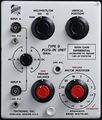D: Difference between revisions
Vintage dave (talk | contribs) (Undo revision 61370 by Vintage dave (talk) - turns out my instrument was field-modified) Tag: Undo |
m (→top: clean up, replaced: {{Plugin Sidebar 2 → {{Plugin Sidebar | designers=, title=Tektronix → manufacturer=Tektronix | model=) |
||
| Line 1: | Line 1: | ||
{{Plugin Sidebar | {{Plugin Sidebar | designers=| | ||
manufacturer=Tektronix | model=D| | |||
summary=Differential amplifier| | summary=Differential amplifier| | ||
image=Tek type d front.jpg | | image=Tek type d front.jpg | | ||
Revision as of 08:55, 9 August 2021
The Tektronix Type D is a differential amplifier plug-in for 500-series scopes.
Type D was the most sensitive plug-in of the original four. The bandwidth depends on the gain, ranging from 2 MHz at 50 mV/div to 300 kHz at 1 mV/div. There are two axes of sensitivity setting: a decade attenuator in front of a gain switch. This scheme would be reprised in Type W.
It displays the difference between two input signals, with a common-mode rejection ratio of 10,000. It has six tubes, on a shock-mounted subchassis to avoid microphonics.
Along with Types A, B, and C, Type D was introduced with the 531 and 535 in 1954.
At the time it was called Type 53D. It was briefly renamed 53D/54D in 1955 with the introduction of the 541 and 545. This quickly changed to 53/54D, and finally shortened to just "D" in 1959 with the introduction of the 5xxA scopes. Its final year in the catalog was 1968; it had been superseded by Type 1A7 and 1A6.
K, L, and T are tied for longest production life, at 16 years. B, D, and G are next at 15 years.
Lavoie Laboratories produced an unauthorized clone, the Lavoie LA-265-D.
Internals
Instruments below serial number 3462 used a pair of 5814 tubes at the input; later production used 12AU7's. These two tube types have different heater currents, and because the heaters are series-wired, you cannot switch from one type to the other without circuit modification.
Key Specifications
| Deflection | 1 mV/Div to 50 V/Div in 1–2–5-10-20-50 sequence and 1-10-100-1000 sequence |
|---|---|
| Input impedance | 1 MΩ // 47 pF (either input) |
| Bandwidth | 2 MHz with MV/CM MULTIPLIER set to 50; 300kHz with MV/CM MULTIPLIER set to 1 |
| CMRR | 10000:1 with MILLIVOLTS/CM set to 1, 1000:1 otherwise |
| Signal ranges |
| Range | Common mode dynamic range* |
|---|---|
| MILLIVOLTS/CM = 1 | ±2.5 V |
| MILLIVOLTS/CM = 10 | ±25 V |
| MILLIVOLTS/CM = 100 | ±250 V |
| MILLIVOLTS/CM = 1000 | ±500 V |
- In practice, Type D behaves well up to about +/-15V if the CM signal is either a brief excursion or a constant. If the CM varies slowly, DC shift in the input tubes will degrade CMRR.
Pictures
-
-
Front
-
Chassis
-
Rubber support for elimination of microphonics
-
Chassis bottom
-
Early Schematic
-
Late Schematic
-
Late Attenuators
-
Front View (vertical position knob not original)









